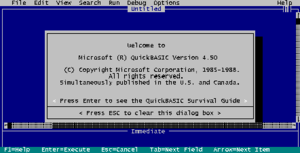 Microsoft QuickBASIC (also QB or incorrectly, "QBasic", which is a different system) is an Integrated Development Environment (or IDE) and compiler for the BASIC programming language that was developed by Microsoft. QuickBASIC runs mainly on DOS, though there was a short-lived version for Mac OS. It is loosely based on GW-BASIC but adds user-defined types, improved programming structures, better graphics and disk support and a compiler in addition to the interpreter. Microsoft marketed QuickBASIC as the introductory level for their BASIC Professional Development System.[1]
Microsoft QuickBASIC (also QB or incorrectly, "QBasic", which is a different system) is an Integrated Development Environment (or IDE) and compiler for the BASIC programming language that was developed by Microsoft. QuickBASIC runs mainly on DOS, though there was a short-lived version for Mac OS. It is loosely based on GW-BASIC but adds user-defined types, improved programming structures, better graphics and disk support and a compiler in addition to the interpreter. Microsoft marketed QuickBASIC as the introductory level for their BASIC Professional Development System.[1]| Appeared in | 1985 - 1988 |
|---|---|
| Designed by | Microsoft Corporation |
| Developer | Microsoft Corporation |
| Stable release | 4.5 (1988) |
| Influenced by | GW-BASIC |
| Influenced | QBasic, FreeBASIC, Visual Basic, QB64 |
| OS | MS-DOS, Mac OS |
| License | MS-EULA |
| Website | www.microsoft.com |
History
Microsoft released the first version of QuickBASIC on August 18, 1985 on a single 5.25" 360kB floppy disk. QuickBASIC version 2.0 and later contained an Integrated Development Environment (IDE), allowing users to edit directly in its on-screen text editor.
Although still supported in QuickBASIC, line numbers became optional. Program jumps also worked with named labels. Later versions also added control structures, such as multilineconditional statements and loop blocks.
Microsoft's "PC BASIC Compiler" was included for compiling programs into DOS executables. Beginning with version 4.0, the editor included an interpreter that allowed the programmer to run the program without leaving the editor. The interpreter was used to debug a program before creating an executable file. Unfortunately, there were some subtle differences between the interpreter and the compiler, so that a program that ran correctly in the interpreter might fail after compilation, or not compile at all.[citation needed]
The last version of QuickBASIC was version 4.5 (1988), although development of the Microsoft BASIC Professional Development System (PDS) continued until its last release of version 7.1 in October 1990.[2] At the same time, the QuickBASIC packaging was silently changed so that the disks used the same compression used for BASIC PDS 7.1.[3] The Basic PDS 7.x version of the IDE was called QuickBASIC Extended (QBX), and it only ran on DOS, unlike the rest of Basic PDS 7.x, which also ran on OS/2. The successor to QuickBASIC and Basic PDS was Visual Basic for MS-DOS 1.0, shipped in Standard and Professional versions. Later versions of Visual Basic did not include DOS versions, as Microsoft concentrated on Windows applications.
A subset of QuickBASIC 4.5, named QBasic, was included with MS-DOS 5 and later versions, replacing the GW-BASIC included with previous versions of MS-DOS. Compared to QuickBASIC, QBasic is limited to an interpreter only, lacks a few functions, can only handle programs of a limited size, and lacks support for separate program modules. Since it lacks a compiler, it cannot be used to produce executable files, although its program source code can still be compiled by a QuickBASIC 4.5, PDS 7.x or VBDOS 1.0 compiler, if available.
QuickBASIC 1.00 for the Apple Macintosh operating system was launched in 1988. It was officially supported on machines running System 6 with at least 1 MB of RAM.[4] QuickBASIC could also be run on System 7, as long as 32-bit addressing was disabled; this was not possible on Motorola 68040-based Macintosh machines.
[edit]Current uses
QuickBASIC continues to be used in some schools, usually as part of an introduction to programming, though it is fast becoming replaced by more popular compilers. It also has an unofficial community of hobby programmers who use the compiler to write games, GUIs and utilities.[5][6][7] The community has dedicated several Web sites, message boards and online magazines to the language.[8][9][10][11]
Today, programmers often use DOS emulators, such as DOSBox, to run QuickBASIC on Linux and on modern hardware that no longer supports the compiler.[12][13]
Recently, a set of TCP/IP routines for QuickBASIC 4.x and 7.1 has revitalized some interest in the software. In particular, the vintage computer hobbyist community has been able to write software for old computers that run DOS, allowing these machines to access other computers through a LAN or the internet. This has allowed systems even as old as an 8088 to serve new functions, such as acting as a Web server or using IRC.[14]
QuickBASIC 4.5 is still available for download for MSDN Subscribers.
[edit]Successors
Microsoft's Visual Basic was the successor of QuickBASIC. Other compilers, like PowerBASIC and FreeBASIC, have varying degrees of compatibility. QB64, a multiplatform QuickBASIC compiler, is being developed and aims to be 100% compatible.[15]
No comments:
Post a Comment